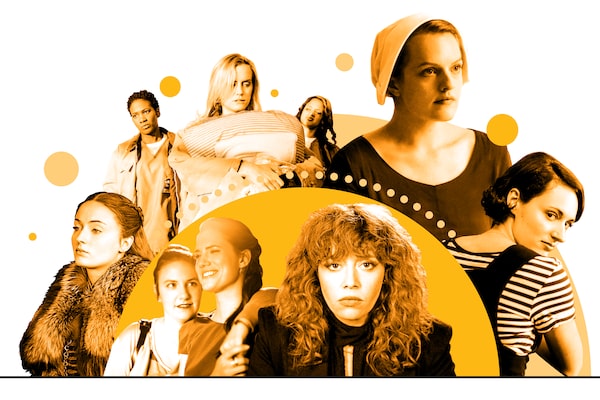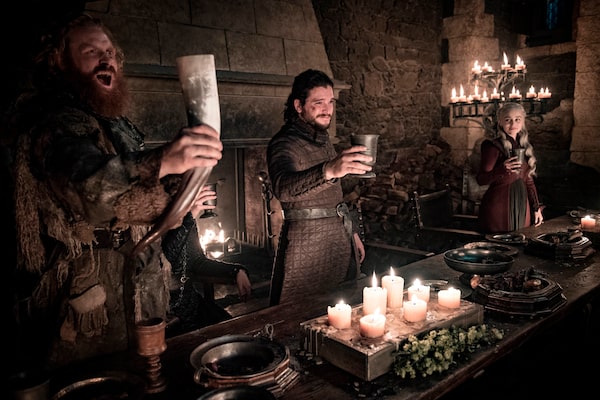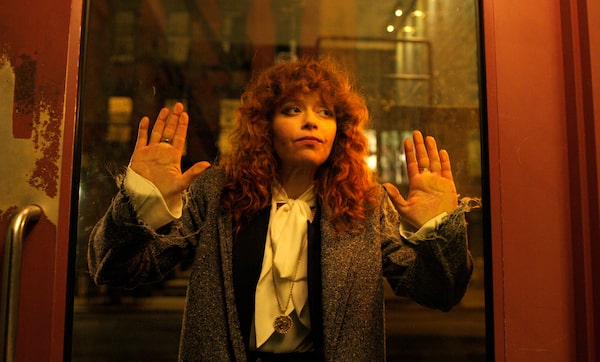
The past decade of great TV, from Lena Dunham’s Girls on HBO to The Handmaid’s Tale to Fleabag and others, is an aesthetic, socioeconomic and cultural phenomenon that belongs to women.Illustration by The Globe and Mail
There is a school of thought that suggests the long-form TV series is the defining cultural form of the 21st century. That’s fair. The literary novel defined the 19th and most of the 20th century and the decline of the literary novel’s prestige is something that writers moan about constantly. As for the argument that cinema defined the past century, that argument was lost long ago when cinema went to a galaxy far, far away and then comics became the anchoring content.
The pre-eminent cultural significance of long-form TV was one striking aspect of the stay-at-home phenomenon that accompanied the arrival of the coronavirus pandemic. People reached for a binge-watch of excellent TV drama not just as escapism or distraction but as a way of grappling with the changed reality they face and society faces. It wasn’t the canon of great novels that offered solace and meaning.
At the same time, there’s also a school of thought that long-form TV declined in quality of seriousness and psychological depth as the 2010s ended. The diagnostic stance taken by scholars and some critics is that for much of the first period of this Golden Age of TV, attention to the interior life of protagonists was the primary hallmark of such dramas as The Sopranos, Six Feet Under, Mad Men and Breaking Bad. In all these shows both the public and the domestic lives of key characters were explored with an emphasis on personal anxiety and guilt.
As some critics and scholars see it, the psychological depth disappeared around the time Game of Thrones became the representative and most popular series of the late 2010s. Thrones was spectacle and surface, not depth. Its main characters were figures with sociopathic, sadistic urges but no inner life or introspection. And so, it is concluded, an era is over, and the dramatization of psychological and sociological phenomena as the bedrock of the best TV storytelling ends with it.

Kristofer Hivju, left, Kit Harington and Emilia Clarke in a scene from Game of Thrones.Helen Sloan/The Associated Press
Consider the impact of HBO’s Game of Thrones and how it compelled Netflix to invest in such depthless fantasy material as The Witcher and Locke & Key and how it obliged other outlets to invest in The Magicians and His Dark Materials. Consider how the rise of such distracting but superficial material coincides with the rise of politicians in the United States, Britain and elsewhere who seem to lack an inner life. It all amounts to a major decline in one-dimensional politics and culture. That’s one thesis.
I would argue against that. Another and more legitimate through-line in the past decade of great TV starts with Lena Dunham’s Girls on HBO and runs through FX’s Better Things to The Handmaid’s Tale to Fleabag, Netflix’s Unbelievable and others. This line is an aesthetic, socioeconomic and cultural phenomenon. The future of great TV is female; the past was male.
It’s an indisputable fact that the material that came to revolutionize TV, starting roughly in the year 2000, was created by hardnosed men – David Chase, David Simon, Alan Ball, David Milch, Vince Gilligan and Matthew Weiner. The spine of the best book to date on the era, Difficult Men by Brett Martin, is the observation that these “difficult” men unleashed shows that were mainly about troubled, brooding men who were at war with themselves and the world. Tony Soprano and Don Draper’s stories were about emotional and psychological torment that was male.
Elisabeth Moss as Offred in 'The Bridge' episode of The Handmaid's Tale.George Kraychyk/Courtesy of manufacturer
We have to pull back from easy diagnoses and labels. It is important to note that no cultural phenomenon simply begins with a group of artists and storytellers appearing out of nowhere to present their work and change a genre or medium. This Golden Age of TV, like other shifts in the culture, happened thanks to an accidental confluence of economics, technology and societal change.
In the late 1990s premium cable channel HBO found that it lost a certain number of subscribers at the end of each quarterly billing period. It wanted to find out why. Close study – focus groups and interviews with former subscribers – indicated that many customers paid for the channel to see a certain number of movies. Mainly these were non-mainstream movies, the genre of film that would never appear at the local multiplex. When they’d seen that content there was little to keep the customer attached to HBO.
One factor that did manage to hook some customers was the original content, those HBO movies, documentaries and, tellingly, the satiric comedy The Larry Sanders Show. The satirical take on a late-night talk show had begun accumulating awards and had both cult status and cool quotient. HBO began exploring doing more original series to keep the customers satisfied. And, important, it began to see the 10- to 13-episode season for original content as important because the series would overlap quarterly billing periods and subscribers would be reluctant to drop the service if they had not seen an entire season of a show they were hooked on. That’s the economics of it.

Phoebe Waller-Bridge in Amazon Prime's award-winning comedy series Fleabag.The Associated Press
At the same time, HBO existed as a service acquired through two methods: cable and satellite. Literally, for many people having HBO meant a cable being attached to the TV set. Cable penetration was slow in the United States In 1990, there were only 51 million homes with cable. HBO had been using satellite transmission since the 1970s but satellite was an expensive option for the customer. Starting in 2000, satellite became cheaper and such channels as HBO and Showtime found a new way to reach more new subscribers. (We all remember when satellite dishes the size of dinner plates began appearing on the roofs or walls of ordinary homes.) The delivery of quality TV became easier and that delivery issue was crucial in seeding the growth of the Golden Age of TV.
Meanwhile, another advance in technology was making viewers comfortable with watching multiple episodes of TV shows instead of waiting for weekly episodes. The advent of DVDs in the late 1990s meant people could rent or buy an entire season of a TV series they had missed and thus began the binge-watch phenomenon. (An interesting footnote here: According to legend, Silicon Valley veteran Reed Hastings founded Netflix as a DVD-rental operation in 1997, partly out of frustration after being fined $40 by Blockbuster for being late in returning a movie he had rented.) Also, people began to experience the viewing of a series as something akin to reading a novel. In the predigital era, all the ingredients for an explosion of stellar and prestige TV content were coming together.
Helping the situation was a new market for independent film created by the hunger of video-store chains for new material. Such indie movies as Richard Linklater’s Slacker (1990) and Kevin Smith’s Clerks (1994) found a vast audience by being released on VHS, later on disc, to the rental stores. There was suddenly a large audience for non-mainstream entertainment outside metropolitan centres, and people who rented or bought the content were experiencing it in their homes. Cable TV began to cater to that audience.
This confluence of economics, technology and delivery systems mirrors the rise of the English-language literary novel in the mid-19th century. The industrial revolution had created a middle-class readership that had leisure time and was hungry for narratives that dealt with society and with the inner-self that had suddenly been revealed to them. In having leisure time it emerged that not all of life was merely about the struggle to survive. Introspection became an actual activity. The novel became a vital source of both enlightenment and distraction. And the novel exploded as a genre because the production of books became cheaper, making them easily affordable. The key delivery system was the railway. Books could be produced in mass quantity and shipped to the most remote consumer via the railway.
In its 10- to 13-episode format, the prestige TV of the early part of this Golden Age began to mimic the literary novel. David Simon’s The Wire seems distinctly novel-like in its in-depth depiction of Baltimore, with entire seasons devoted to layers of the city from politics to policing, to labour unions to criminal activity. Mathew Weiner’s Mad Men unfolded as a great American novel might – the poetic rhythms of American life were at its core and its core theme was that the past can be shed but it cannot be undone; rebirth of the self is an entitlement; money changes everything and romance is around every corner. In the end, Don Draper, an archetypal character of American fiction, someone who literally reinvented himself by taking another’s man identity, even drifted west to the frontier, that most quintessential of acts in American fiction.

From left, actors Clark Johnson, Brandon Young, Michelle Paress, and Tom McCarthy in a scene from The Wire.Paul Schiraldi
Artists will always be drawn to the medium that allows them to ask the big questions and tell the big stories while reaching the largest audience. And so it was that when Lena Dunham’s Girls debuted in 2012, it had been 13 years since The Sopranos began airing. In her 20s, Dunham had grown up in an era when cable television was becoming the defining storytelling medium of the new century. What had already been wrought by those “difficult” men gave her the freedom to make Girls into the blackly comic, poignant stew that it became.
So began this important thread in the development of serious TV storytelling. And overlooked, of course, by some critics and scholars, because it is essentially female-centric. Everything about Girls was startling: comedy but subtle, fiction that felt grounded in reality, sometimes loving and sometimes brutal about its smug, entitled but very brittle characters. It was annoying, intense, hilarious and sometimes deeply moving.
The landscape was shifting by the time Walter White died and Breaking Bad ended in 2013. Showtime had unleashed a thriller, Homeland, about intelligence work and terrorism but featuring as its anchor character the profoundly complicated Carrie Mathison, and gave Claire Danes the role of a lifetime. At that point, too, Netflix was beginning to have a significant impact and the streaming service offered another avenue for women writers, directors and producers to tell stories. With Orange is the New Black, Jenji Kohan took the original material, about a Caucasian woman, Piper Chapman (Taylor Schilling) doing jail time, and expanded it to portray the lives and backgrounds of the inmates – black, Hispanic, and LGBT women. One pithy review of early episodes of Orange is the New Black said it “depicts the alarming reality of being a liberated woman in a world run by men.”
Then along came filmmaker Jane Campion’s Top of the Lake, with Elisabeth Moss, so familiar to viewers as Peggy in Mad Men, in the main role as Robin, a young police detective specializing in crimes against women and children. (It’s notable that the series found a home on Sundance TV, a new streaming service.) Some saw the plotline of the mini-series as an outright attack on masculinity. And in many ways it was. Moss is a revelation in the series, which as is as far from the office politics of Mad Men as it is possible to journey. Robin is a deeply complex character – depressed, angry, strong, flawed and at times on the edge of disintegration.
It’s possible to use Elisabeth Moss to form a thread that links multiple important achievements in TV in the past few years, and to see how those achievements illustrate the rise of female storytelling. Given that Moss would be the ballast of The Handmaid’s Tale, it would be tempting to see her body of work as a symbolic blossoming of the Peggy figure in Mad Men from the end of the 1960s to the contemporary and the 2020s.
But, just as an assemblage of economic, technological and cultural forces brought this Golden Age of TV into being, a convergence of influences was necessary to push women and their perspective to the forefront. As television kept expanding with more specialty and niche cable channels, then more streaming services, the industry desperately needed more female voices behind the camera. What was needed was a public acknowledgement.
One came from writer/producer Ryan Murphy in 2015. Murphy had created his own empire of shows on Fox and FX, including Glee, American Crime Story, American Horror Story, Scream Queens, and the mini-series Feud. As a gay man in the industry Murphy had felt isolated from the start. That start was in 1999 when his creation, the comedy Popular, was picked up by the WB network. Murphy said later, “When you see who men choose to mentor, for the most part it’s people just like them, but two inches shorter and 20 years younger.”
Murphy established Half, a foundation within his production company aiming to diversify Hollywood, and committed to having 50 per cent of all director gigs on his shows going to either women or minority candidates, which he defined as people of colour or members of the LGBTQ community. By the end of 2016, 60 per cent of his directing jobs were given to women. In the TV industry in general, only about 17 per cent of directors are women.
The year 2016 was crucial. Like almost everything in Trump-era United States, the shifting ground of TV storytelling is enmeshed in Trump politics. Trump’s victory in 2016 and the polarizing, bewildering campaign from which he emerged victorious, energized forces that had been dormant. The first Women’s March on Jan. 21, 2017, the day after the inauguration of Trump, was a response to Trump himself and the pervasive misogyny he embodied. It was one of the largest single-day protests in U.S. history. The atmosphere surrounding it gave extra potency to The Handmaid’s Tale when the dystopian drama began airing on Hulu in April of 2017.
Six months later the New York Times published a story detailing decades of allegations of sexual harassment against Hollywood mogul Harvey Weinstein. Actress Alyssa Milano enkindled the “#MeToo” campaign with the tweet, “If you’ve been sexually harassed or assaulted write ‘me too’ as a reply to this tweet.” It quickly ignited what turned into a movement. Within months, comedian, writer and producer Louis C.K, broadcaster Matt Lauer, CBS CEO Leslie Moonves, and many others, would be disgraced figures. With each new season of The Handmaid’s Tale, June, the figure played by Elisabeth Moss, would seem even more emblematic.

Natasha Lyonne’s Russian Doll on Netflix is entirely about the internal life of the main character Nadia.Netflix via The Associated Press
The adaptation of Margaret Atwood’s novel was never going to be an easy sell to a broadcaster and it is significant that it streamed on Hulu in the United States. One of a burgeoning number of new digital services, it needed content to attract attention and that need, shared by Netflix, Amazon Prime Video, and later AppleTV+ and others, provided – and continues to provide – a route for women to tell stories about women, and it means that competing delivery services are there to distribute those stories. Once again, an enormous cultural shift was given agency and enabled by economics and technology.
If the best TV of 2019 – the productions nominated for an Emmy Award, Golden Globe or other awards is a signpost to the best TV of the 2020s, then this decade will be dominated by women telling incisive, frank, often explicit stories about women. Pamela Adlon’s Better Things on FX, with its blunt portrayal of menopause, would have been unthinkable a few years ago. Krystal Stubbs (Kirsten Dunst), the central figure in Showtime’s On Becoming a God in Central Florida, is a struggling mother, former pageant queen and an emphatically tough, rounded woman. She has an inner life that is rawly exposed.
Natasha Lyonne’s Russian Doll on Netflix is entirely about the internal life of the main character Nadia, who keeps dying during her 36th-birthday party only to return over and over, as another layer of the external self is exposed. Framed almost as a mystery, the mystery is solved by drilling down to Nadia’s inner numbness, self-loathing and vulnerability about how she appears to others. The series can be summed up as “the crisis of the self.” Specifically, it’s the female, 36-year-old self. In Phoebe Waller-Bridge’s Fleabag (seen on Amazon Prime outside Britain) the main character’s internal life is the entire point of the series. She is constantly re-examining herself and even breaking the fourth wall to reveal more about herself.

Merritt Wever, left, and Toni Collette in Netflix's true crime series Unbelievable.Beth Dubber/The Associated Press
Unbelievable, which arrived on Netflix last year, is another work that would have been unthinkable or impossible to produce a decade ago. It takes a true story and a chilling statistic – that only a tiny percentage of sex crimes reported to police are solved – and turns them into a crime story in which the police-procedural genre is smashed to smithereens. It is smashed by the skeptical female gaze on the genre. Unbelievable also had added potency in the context of so many powerful men finally being punished or disgraced for their actions.
These series – and they make up only a partial list – reassert that the long-form TV series is the defining cultural form of the 21st century. Nothing ended with the end of Game of Thrones. While it was ending another beginning was under way, a multitude of voices was emerging and those voices, resonant and sometimes abrasive, are women taking television storytelling forward with even more seriousness than came before.
Plan your screen time with the weekly What to Watch newsletter, with film, TV and streaming reviews and more. Sign up today.



